
table of contents
- Domestic winter birds
- Birds from A - D
- Birds from E - G
- Birds from H - L
- Birds from M - Z
- frequently asked Questions
Before the cold season begins, cranes, storks, swifts, house martins and Co. migrate to the warm south. Other bird species overwinter here. We present 15 resident birds that are native to Germany.
In a nutshell
- Migratory birds spend the winter in the warm south
- Resident birds have adapted to the conditions and stay in an area all year round
- more and more former migratory birds are becoming resident birds due to climatic changes
- Resident birds feed on grains, nuts and seeds in winter
Natural gardens provide shelter and food for resident birds
Domestic winter birds
Who can resist the fascination of the bird world? In winter, the bird feeder in front of the window offers the chance to experience birds up close. Resident birds that hibernate with us have adapted perfectly to the conditions. When there are only a few worms and insects left, they feed on nuts, grains and seeds.
Birds from A - D
Blackbird (Turdus merula)
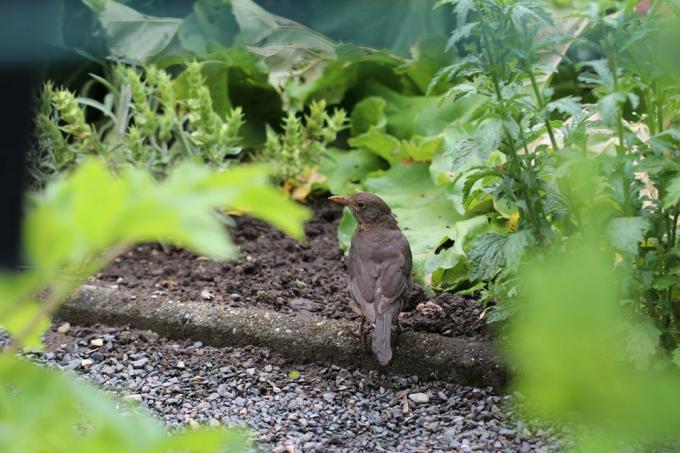
- Males: black with a yellow bill
- Female: brown
- Length: 25.5 centimeters
- Call: dag-dag
- Singing: loud, fluting
- Habitat: parks, gardens, forests
- Food: worms, caterpillars, fruits, grains
- Breeding season: April
- Characteristic: The black winter bird is not shy and well used to being close to humans.
- Other names: Black Thrush
Chaffinch (Fringilla coelebs)

- Males: red-brown chest and cheeks, blue-gray cap, white wing bands, gray beak
- Females: green-brown, less conspicuous than the male
- Length: 15 centimeters
- Call: pink-pink
- Singing: loud, trilling
- Habitat: deciduous and mixed forests, orchards, parks
- Diet: insects, spiders, seeds, grains, beechnuts
- Breeding season: April and June
- Characteristic: males overwinter in the same place, females move further south.
- Other names: Edelfink
Great spotted woodpecker (Picoides major)
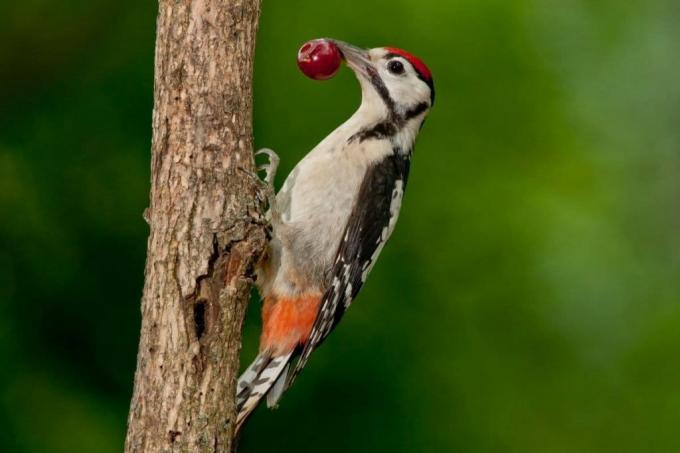
- Males: black-white-red plumage, red stripe on the back of the head
- Females: black-white-red plumage
- Length: 23 centimeters
- Call: kix
- Habitat: forests, gardens, parks, cemeteries
- Food: worms, caterpillars, spiders, bird eggs, young birds, nuts, grains
- Breeding season: April
- Characteristic: Great spotted woodpeckers overwinter in tree hollows. Their knocking can be heard from afar, especially during courtship.
- Other names: Baumhacker
Jackdaw (Coloeus monedula)
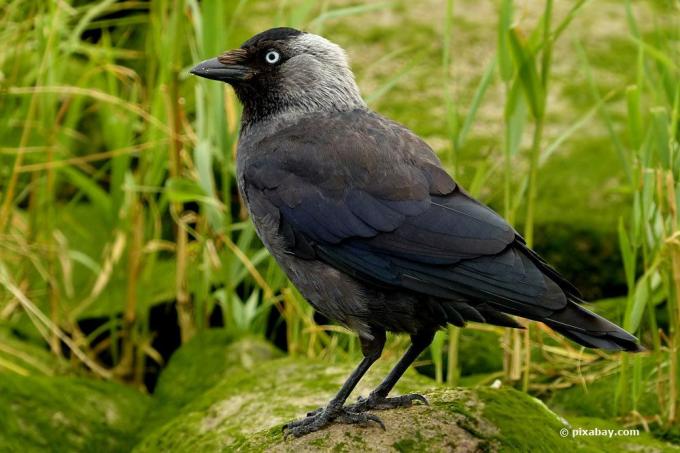
- Males and females: black with iridescent reflections, the back of the head and neck gray, short beak and tail, light blue eyes
- Length: 36 centimeters
- Call: kjakk
- Singing: gossiping, polyphonic in large groups
- Habitat: caves in trees and rocks, wall holes, gardens, parks, mixed forests
- Food: insects, larvae, snails, worms, berries, seeds
- Breeding season: April to June
- Characteristics: The number of jackdaws has declined significantly in recent years. The intelligent winter bird is on the red list of endangered species.
- Other names: little monks
Birds from E - G
Eurasian Jay (Garrulus glandarius)

- Males and females: light red-brown body, black and white wings with light blue iridescent feathers, black beard stripes, light blue eyes
- Length: 34 centimeters
- Reputation: Screaming reminiscent of the meowing of cats
- Habitat: oak forests
- Diet: insects, spiders, caterpillars, seeds
- Breeding season: April to May
- Feature: The intelligent standing bird is able to imitate the voices of other birds.
- Other names: gardener of the forest
By the way, the jay can carry up to ten acorns in its throat pouch. The impressive winter bird buries the acorns in the ground and thus creates supplies for wintering. With this peculiarity, the resident bird, which does not find all of its acorns again in winter, ensures the spread of oak trees.
Siskin (Carduelis spinus)

- Males: chest, rump, wing bands yellow-green, black forehead and black throat, long beak
- Females: rump, wing bandages yellow-green, light gray head, long beak, breast dashed
- Length: 12 centimeters
- Reputation: teterett
- Singing: chirping (only males sing)
- Habitat: coniferous and mixed forests with alder and birch
- Food: birch and alder seeds, grains, nuts
- Breeding season: April and July
- Characteristic: The winter bird looks very similar to girlitzes and greenfinches.
- Other names: hosiery
Bullfinch / Bullfinch (Pyrrhula pyrrhula)

- Males: red belly, light gray back, black head. Females: gray-pink belly, gray back, black head
- Length: 14 to 17 centimeters
- Call: you
- Singing: soft, chatting, melancholy
- Habitat: coniferous forests
- Diet: berries, seeds, fruit tree buds
- Breeding season: April and late June
- Characteristic: The jumping movement gave the bullfinch its name. The Bavarian word "gumpen" stands for "hop". Other names: bullfinch, blood finch
Note: Don't cut back all of the perennials in your garden in the fall. The faded flowers make it easier for the bullfinch to overwinter, because they provide valuable food for the beautiful resident bird in winter.
Greenfinch (Carduelis chloris)

- Males: olive-green body, distinctive yellow markings on the wings, light-colored beak
- Females: gray-olive green, less conspicuously drawn than the male
- Length: 15 centimeters
- Call: jüpp or djüp-rüp-rüp
- Singing: trilling
- Habitat: Settlements, parks, gardens, cemeteries, open forests
- Diet: seeds, grains, rose hips
- Breeding season: April to June
- Characteristic: The sociable winter bird can usually be seen in groups at the aviary. Other names: Grünling, Zwuntsch
Birds from H - L
Black redstart (Phoenicurus ochruros)
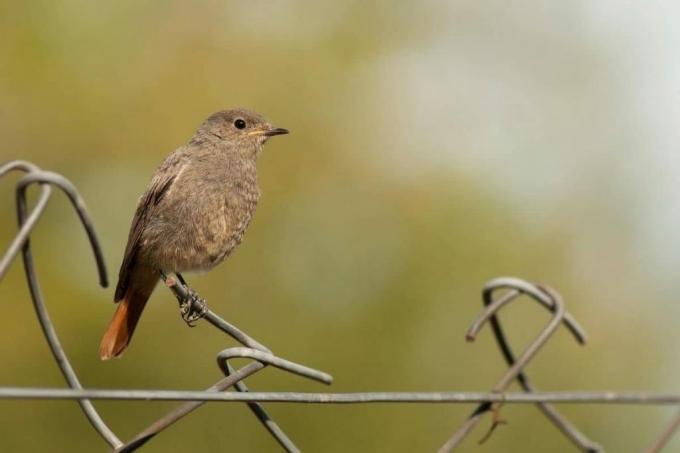
- Males: black body, red tail
- Females: gray body, red tail
- Length: 15 centimeters
- Call: jirr tititi
- Singing: not melodic, squeezed
- Habitat: caves
- Food: insects, spiders, worms, larvae, seeds, berries
- Breeding season: May to June
- Characteristic: The winter bird used to be a rock dweller. Today it is also native to the plains.
- Other names: Rotschwänzle, Brandvogel, Rußvogel
Note: By hanging up a semi-cave, gardeners can support the small resident bird during the winter.
House Sparrow (Passer domesticus)

- Males: gray-brown plumage, black throat, gray crown, brown stripes on the sides of the head, brown back with white stripes, strong beak
- Females: dull brown
- Length: 14 to 15 centimeters
- Call: chilp
- Habitat: villages with agriculture, parks, gardens
- Diet: cereal grains, seeds
- Breeding season: April and June
- Characteristic: The term "Dreckspatz" refers to the small birds' preference for bathing in the sand.
- Other names: sparrow, house sparrow
Nuthatch (Sitta europaea)

- Males and females: back blue-gray, belly beige-brown, pointed long beak, black eye stripes, white neck
- Length: 12 to 15 centimeters
- Call: wi-wi-wi
- Habitat: deciduous and mixed forests with a lot of old wood
- Diet: insects, spiders, caterpillars, seeds
- Breeding season: April to May
- Feature: The resident bird can run down the tree trunks upside down.
- Other names: woodpecker tit
By the way, the name of the glue comes from the word "glue". The resident bird has the ability to reduce the size of the entrance to its breeding cave by gluing small balls of clay.
Great tit (Parus major)
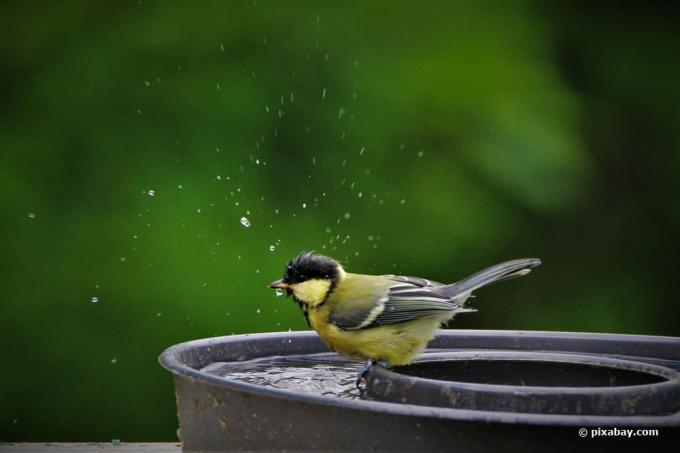
- Males and females: yellow belly, black head, white cheeks
- Length: 14 centimeters
- Call: pink-pink, in spring: si-si-däh
- Singing: varied, metallic
- Habitat: forests, gardens, parks, cemeteries
- Food: worms, caterpillars, spiders, nuts, grains
- Breeding season: April and June
- Characteristic: Great tits from the north are part migrants and overwinter in warmer regions. Most of the great tits in Germany are resident birds.
- Other names: Finch tit
The name of Great tit has nothing to do with the cabbage vegetables. It was created on the basis of the black head reminiscent of coal.
Birds from M - Z
Common buzzard (Buteo buteo)
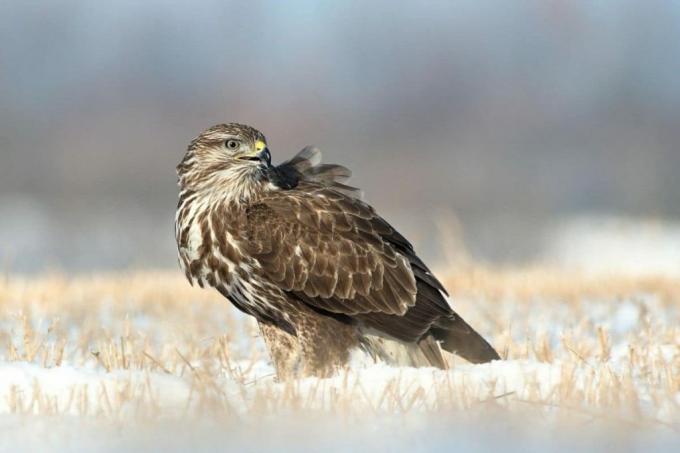
- Males and females: gray-brown banded, white, longitudinally striped goiter, rounded tail
- Length: 48 to 55 centimeters
- Reputation: like the meowing of cats
- Habitat: trees, buildings
- Food: mice, small animals, birds, carrion
- Breeding season: March to June
- Characteristics: Many common buzzards from Scandinavia overwinter in Germany.
- Other names: cat eagle
The name buzzard comes from Middle High German. The word part "Buse" means cat and "Aar" stands for eagle. The mewing call of the bird of prey, which resembles the meowing of a cat, gave it its name.
European robin (Erithacus rubecula)

- Males: head and chest colored red, olive-brown back, white lower abdomen, black eyes
- Females: Color like the male, only a little more dull
- Length: 14 centimeters
- Shout: zig
- Singing: as bright as a bell
- Habitat: gardens, parks, mixed forests
- Diet: insects, berries, seeds
- Breeding season: April to May
Goldfinch (Carduelis carduelis)
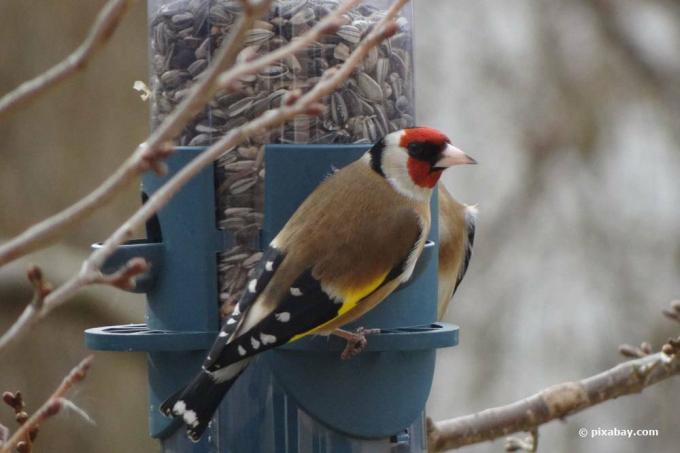
- Males: head red, black and white, back and chest light brown, tail feathers with white spots. Females: color like the male, only a little more dull
- Length: 12 to 13 centimeters
- Call: stiglit, didelit, didilit
- Singing: bright, trilling
- Habitat: settlements, gardens, parks, mixed forests
- Food: insects, herbs, seeds
- Breeding season: April to July
- Characteristics: Goldfinches even live in cities and often breed in schoolyards.
- Other names: Distelfink, Augsburg night watchman
Tip: If you want the colorful goldfinch to feel at home on your property, you shouldn't tidy up your garden intensively in winter and you shouldn't use chemical weedkillers.
frequently asked Questions
No, year-round feeding at the aviary is not recommended by nature conservation associations. The endangered species that are native to Germany do not come to the bird feeder. Year-round feeding leads to an oversupply of individual species such as titmice.
The best protection for the birds is to preserve biodiversity. Create nesting opportunities for birds and small animals. Do not use chemical pesticides. Don't clean up your garden completely. The berries on the bushes are the best food for bird species that are native to our latitudes.
Use only suitable bird seed. Bread crumbs or other leftover food do not belong in the feeder. Do not use tit dumplings in plastic nets. Birds can get tangled up in it. Keep the bird feeder clean. Install the bird house so that cats cannot reach it.
Resident birds, which are native to Central Europe, have a so-called miracle network. It is the principle of heat exchange that keeps birds' feet warm. The warm blood from the body is continuously exchanged for the cold blood from the feet. The delicate legs are protected from freezing. Fluffing also helps in cold temperatures. Many species spend the night together. The community offers shelter from the cold.



